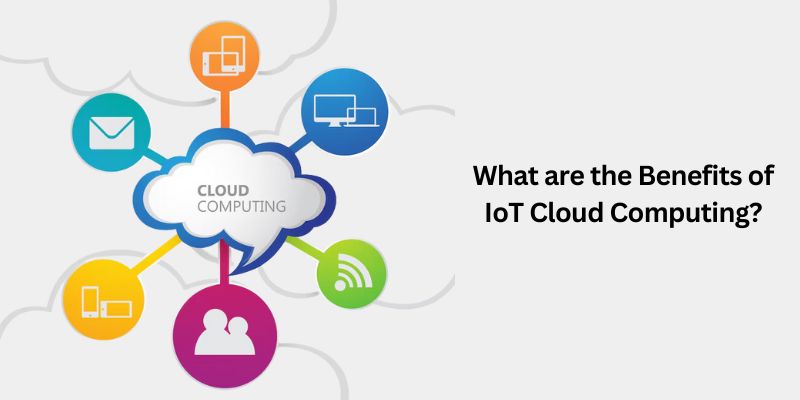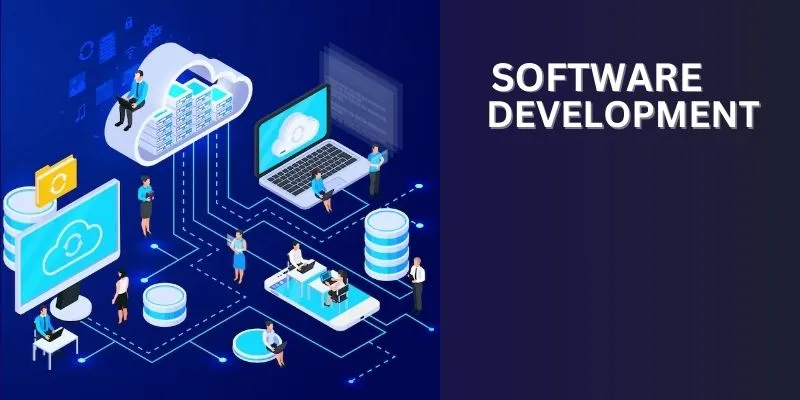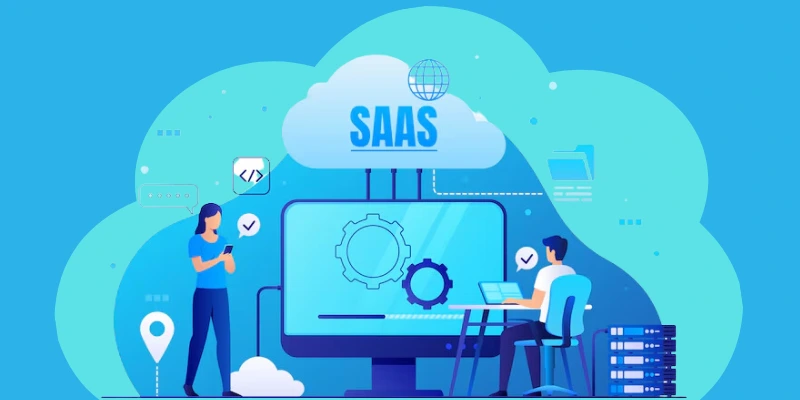Digital transformation has influenced most firms to perform daily operational activities, and transforming from traditional to cloud computing is a great move taken into this. Cloud computing became the primary environment for developing new software, specifically for software developers or IT experts. The latest method of conducting business combines flexibility and efficiency at a price.
Could computing makes it troubling for developers and network administrators to balance the benefits against the potential risks for smooth and efficient operation? Let's examine cloud-based software development in depth.
Read About: Cost Estimation For SaaS, Cloud, and On-Premise Development Solutions
How Do You Define Cloud Computing?
The cloud computing model is a type of infrastructure where processes and resources are outsourced to data centers rather than performed internally. This model relies on the Internet and mainly focuses on delivery, which allows coverage more than possible compared to traditional methods.
Cloud computing often provides services such as data storage, device management, network access, and cybersecurity. The transfer of these services to cloud-based software development infrastructures allows companies to focus on other important work. their efforts in other work. Furthermore, this allows them to adapt their business operations to their needs, allowing them to be altered at any time. This is a major driver behind the innovative and startup cultures.
Read Also: Security Challenges in IoT Software Development and Possible Solutions
What are the Benefits of IoT Cloud Computing?

There is always a silver lining, and cloud computing isn't always one of them. Here are a few huge business benefits that businesses can gain by adopting IoT or cloud computing:
Accessibility And Mobility Of Data
IoT cloud computing created by connected devices is available at any time and from any connected device. This allows stakeholders, such as employees, partners, customers, and employees, to access live data, analysis, and access insights whenever and wherever they want. By providing instant access to information from IoT devices, cloud computing enables companies to make educated decisions quickly.
Decision makers can access crucial data, including performance of operations, metrics for success, and customer behavior, allowing them to react rapidly to the changing conditions in the marketplace for business opportunities. IoT cloud platforms allow collaboration between teams across the globe.
Scalability And Cost-effectiveness
Cloud-based software development platforms provide a scalable infrastructure that is able to handle fluctuations in data volume, connectivity and the demands of users. Businesses can increase or decrease their IoT deployments upwards or downwards rapidly without requiring significant upfront investments or infrastructure improvements. Cloud-based IoT platforms generally offer pay-as-you go pricing, which means that enterprises only pay for products and services they use. This efficient pricing method allows companies to be in sync with their IoT investments to their actual use, minimizing wasted resources and maximizing their utilization. Utilizing cloud infrastructure to support IoT deployments, companies can save on the capital costs that come with the purchase and maintenance of the hardware and software on-premises.
Software development company help businesses to allocate resources efficiently. Additionally cloud-based IoT solutions usually yield reduced total cost of operation (TCO) when compared to traditional on-premises installations. By outsourcing maintenance and management of infrastructure to a cloud-based software development company, companies can lower operational expenses. reduce risk, realize a higher return on investment (return on investment).
Environmental Sustainability And Resource Conservation
By using cloud resources to support IoT information processing, storage companies can drastically reduce their dependence on the energy-intensive infrastructure on premises. Data centers in the cloud are built to improve energy efficiency, which results in lower energy consumption, carbon emissions, compared with traditional data centres.
Cloud-based IoT deployments need smaller amounts of physical hardware like networks, servers, and storage equipment, in comparison to on-premises options. This decrease in hardware footprint results in lower consumption of resources, less electronic waste and less impact on the environment. Cloud providers usually employ eco-friendly computing methods, including renewable energy sources, energy-efficient equipment, and cooling systems for data centers to minimize their impact on the environment. When adopting cloud-based IoT solutions, companies indirectly aid in these efforts to reduce their carbon footprint and aid in the shift to eco-friendly IT infrastructure.
Collaboration And Productivity Improvements
IoT cloud-based software development platforms allow seamless collaboration between teams distributed across the globe by allowing central access to tools, data, and resources. Teams can collaborate on-demand to share information, exchange ideas, and collaborate in projects regardless of geographic whereabouts. This kind of accessibility creates a culture of innovation as well as collaboration. Cloud-based workflows and collaboration tools help to streamline communication, improve project management, and assist in decisions, which results in increased productivity and efficiency. Through removing communication obstacles and enabling transparency in information sharing cloud-based software development platforms help teams accomplish their goals faster and help improve business results. The cloud-based collaborative nature of IoT platforms facilitates knowledge sharing, innovation and cross-functional cooperation. Bringing together different perspectives and skills teams brainstorm new ideas, test concepts and continue to improve more efficiently than traditional collaboration tools.
Disaster Recovery And Data Security
Cloud-based IoT solutions provide comprehensive options for disaster recovery, such as failure over, data replication and backups that are geographically dispersed. In the case of system failure,, natural disaster, cyberattack, companies are able to quickly retrieve their files and re-establish operations with minimal disruption and loss of data. Cloud providers take strict security measures to safeguard sensitive data stored on IoT cloud-based software development platforms. The security measures include top-of-the-line encryption, two-step authentication and advanced security systems for detecting intrusions. These advanced security features assist organizations to protect their IoT deployments from data leaks and cyber-attacks. This isn't all. Cloud-based IoT solutions also guarantee operations continuity by ensuring continuous access to applications and data regardless of disruptions or emergency conditions. Through built-in redundancy and failover options, automated recovery capabilities, businesses can continue operating provide services to customers, and comply with regulatory requirements.
Must Read: Software Development in the Cloud - Advantages and Challenges
Cloud Software May Face Some Challenges In Development
Every software has its own possibilities and challenges, it offers a wide range of possibilities cloud-based software development. Outsourcing can be challenging particularly for businesses that have a working system. Here are the most significant problems that cloud applications goes through.
Uninterruptible seamless interoperability
The main challenge facing companies who are thinking for cloud-based frameworks is interoperability. The code must be compatible with a variety of cloud providers, despite their different. It gets more complicated when portability is an issue. The same code may be a challenge to move from one system to another.
This issues can be resolved by introducing practical standards and making it easier to facilitate access to data across various platforms for software. This is why operating protocols need to be standardized to prevent potential issues with interoperability.
Performance issues
When we talk about cloud computing, we're speaking about physical servers that are disperses. d. However, their location on the internet is crucial and how customers connect to them may affect the experience they provide.
So, it's crucial to plan ahead and determine the data centers that will host your data. It's much simpler to organize everything prior to the time you plan the move after the operations are in place. End-to-end testing is essential. Making a mistake can lead to an inefficient process that will hurt your business over the long haul.
False claims of the ability to scale
Although it's obvious that most cloud computing services offer scalability, it does not mean that it is without the limitations of the service's capacity. Scalability is limited by the resources available to a service therefore if your specific requirements for scaling exceed what the service can provide it is possible that you will be stuck with a solution that isn't able to meet your requirements.
The biggest risk is choosing a predefined software that's as much as flexible or adaptable to your specific needs. In some instances, using an alternative model will allow you to get the most effective solutions from the top of the line.
Reliability and accessibility
While cloud models can help to ensure high uptime for cloud-based apps but this is not the case always. Cloud providers typically don't offer 24/7 service, and therefore outages may be unresolved. Additionally, the service provider may not provide timely information about maintenance schedules, or other issues.
This will require additional effort from the client's side. Cloud services must be monitored with extra tools. Services' use and performance should be something unique that the company is aware of at all times.
Dependence on the service
When creating applications, it's practical to modify the application to function optimally within the cloud environment. But, it also comes with the effect of making you dependent on an external partner to run your business. Sometimes, switching providers can be costly and time-consuming. It could also be difficult in terms of technical aspects.
Your service should adhere to good design practices to avoid getting caught up in the underlying logic of your service in the event that a company decides to shift operations to another place. Developers must be aware of knowing the specifics of different protocols and proactively adjusting the behavior of applications.
Modes of programming
The development of cloud-based applications require different skills in programming. Although most developers are acquainted with SQL operations that pass on functions specific to applications that are aligned with federated databases. It is worth mentioning that cloud-based software doesn't perform the same wa like Node.Js.So, it is necessary for developers to implement queries-oriented processing to generate the federated data sets that can perform complicated queries or function compositions which are more compatible in cloud computing frameworks.
Security of applications
The outsourcing of such essential components as Cloud-based software development for applications implies that their access must be restricted. This poses a security issue because of the delivery model for web applications and the current state of browsers.
Read About: An Ultimate Guide to Developing Cloud Based SaaS Apps
Steps For The Security Of Cloud-Based
Moving workflows that are developed in the cloud are among the most significant decisions companies can make ever first time in their life. While it offers many benefits to developers, it also raises among the biggest issues related to cloud computing. Here's how it can be improved.
Set governance guidelines
The clear and well-defined governance policies assist in ensuring the security of cloud-based software development. They establish procedures and policies in place, and provide employees specific guidelines in the workplace.
When they are in line with your company's internal security standards, these policies establish a comprehensive framework that defines the operational standards for your entire organization. This ensures that security is uniform all over the board, resulting in clear procedures.
Segment your network
A method of architecturally dividing networks into smaller sections helps to mitigate security risks that could arise in the event of data breaches. Because the free movement of the network is limited and hackers are isolated within a subnet, limiting the speed and duration during that, they are able to go undetected. launch an attack.
Resource are shared among segments, meaning that no need for additional processing power. Furthermore, this strategy is secure and permits control of the flows of traffic between the subnets, based on the granular rules.
Automate security procedures
Security automation is an important element of a effective cloud software development operation model. Code analysis can be automated in the development and testing stages. Additionally practices such as infrastructure,code can be automated to manage configuration. Furthermore, a variety of threats could be quickly dealt with without intervention from humans, thereby avoiding possible injury.
Management of vulnerability in the conduct
Evaluation, identification, and reporting on security vulnerabilities is an essential process helps in securing custom software development. Applications must be offered to customers when they're not resolved due to vulnerabilities that are known to exist. In the absence of this, hackers can easily attack their weaknesses. The mechanisms for penetration testing are required to identify potential vulnerabilities more effectively and makes difficult to address the most critical issues.
Check security regularly
The security practices of an organization must be in line with their policies. If they don't, it can trigger an incident in cybersecurity. Continuous evaluations of security practices ought to be a part of cybersecurity strategies' foundations. Numerous improvements need to be thought of to help set goals and measure progress.
Wrapping It Up
Cloud-first is an established strategy for organising infrastructures in businesses of the present it is also one of the most crucial areas of contemporary cybersecurity. The development of software applications heavily rely upon cloud-based computing in order to do most difficult tasks possible, but it is essential to ensure that the cloud is secure.
Having years of experience in cloud-based software development, aiming to provide native tools that incorporate ZTNA practices as part of the Secure Service Edge model. Ensuring secure remote access by using encryption to protect traffic from beginning to end is a way to protect information, regardless of whether stored locally or in the cloud.
Features such as IP allowlisting allow administrators of networks to approve authenticated connections, and stop all other connections. This helps create an airtight system that can provide an encrypted access model when using cloud services from outside.





.webp)







Share this blog